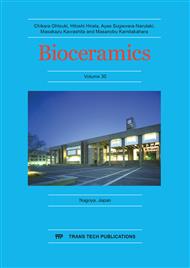[1]
A.L. Harvey, Natural products in drug discovery, Drug Discov. Today 13 (2008) 894-901.
DOI: 10.1016/j.drudis.2008.07.004
Google Scholar
[2]
B. Shen, A new golden age of natural products drug discovery, Cell 163 (2015) 1297-1300.
DOI: 10.1016/j.cell.2015.11.031
Google Scholar
[3]
O. Kepp, L. Galluzzi, M. Lipinski, J. Yuan, G. Kroemer, Cell death assays for drug discovery, Nat. Rev. Drug Discov. 10 (2011) 221-237.
DOI: 10.1038/nrd3373
Google Scholar
[4]
F.M. Balis, Evolution of anticancer drug discovery and the role of cell-based screening, J. Natl. Cancer Inst. 94 (2002) 78-79.
Google Scholar
[5]
W.H. Zimmermann, C. Fink, D. Kralisch, U. Remmers, J. Weil, T. Eschenhagen, Three-dimensional engineered heart tissue from neonatal rat cardiac myocytes, Biotechnol. Bioeng. 68 (2000) 106-114.
DOI: 10.1002/(sici)1097-0290(20000405)68:1<106::aid-bit13>3.0.co;2-3
Google Scholar
[6]
E. Cukierman, R. Pankov, K.M. Yamada, Cell interactions with three-dimensional matrices, Curr. Opin. Cell Biol. 14 (2002) 633-640.
DOI: 10.1016/s0955-0674(02)00364-2
Google Scholar
[7]
M. Honda, T.J. Fujimi, S. Izumi, K. Izawa, M. Aizawa, H. Morisue, T. Tsuchiya, N. Kanzawa, Topographical analyses of proliferation and differentiation of osteoblasts in micro- and macropores of apatite-fiber scaffold, J. Biomed. Mater. Res. A 94 (2010).
DOI: 10.1002/jbm.a.32779
Google Scholar
[8]
J.C. Mei, A.Y. Wu, P.C. Wu, N.C. Cheng, W.B. Tsai, J. Yu, Three-dimensional extracellular matrix scaffolds by microfluidic fabrication for long-term spontaneously contracted cardiomyocyte culture, Tissue Eng. Part A 20 (2014) 2931-2941.
DOI: 10.1089/ten.tea.2013.0549
Google Scholar
[9]
J.U. Lind, T.A. Busbee, A.D. Valentine, F.S. Pasqualini, H. Yuan, M. Yadid, S.J. Park, A. Kotikian, A.P. Nesmith, P.H. Campbell, J.J. Vlassak, J.A. Lewis, K.K. Parker, Instrumented cardiac microphysiological devices via multimaterial three-dimensional printing, Na.t Mater. 16 (2017).
DOI: 10.1038/nmat4782
Google Scholar
[10]
N.M. Mordwinkin, P.W. Burridge, J.C. Wu, A review of human pluripotent stem cell-derived cardiomyocytes for high-throughput drug discovery, cardiotoxicity screening, and publication standards, J. Cardiovasc. Transl. Res. 6 (2013) 22-30.
DOI: 10.1007/s12265-012-9423-2
Google Scholar
[11]
D. Sinnecker, K.L. Laugwitz, A. Moretti, Induced pluripotent stem cell-derived cardiomyocytes for drug development and toxicity testing, Pharmacol. Ther. 143 (2014) 246-252.
DOI: 10.1016/j.pharmthera.2014.03.004
Google Scholar
[12]
M. Larsen, V.V. Artym, J.A. Green, K.M. Yamada, The matrix reorganized: extracellular matrix remodeling and integrin signaling, Curr. Opin. Cell Biol. 18 (2006) 463-471.
DOI: 10.1016/j.ceb.2006.08.009
Google Scholar
[13]
M. Kawata, H. Uchida, K. Itatani, I. Okada, S. Koda, M. Aizawa, Development of porous ceramics with well-controlled porosities and pore sizes from apatite fibers and their evaluations, J. Mater. Sci. Mater. Med. 15 (2004) 817-823.
DOI: 10.1023/b:jmsm.0000032823.66093.aa
Google Scholar
[14]
M. Aizawa, H. Shinoda, H. Uchida, I. Okada, T.J. Fujimi, N. Kanzawa, H. Morisue, M. Matsumoto, Y. Toyama, In vitro biological evaluations of three-dimensional scaffold developed from single-crystal apatite fibres for tissue engineering of bone, Phosph. Res. Bull. 17 (2004).
DOI: 10.3363/prb1992.17.0_262
Google Scholar
[15]
A. Habara-Ohkubo, Differentiation of beating cardiac muscle cells from a derivative of P19 embryonal carcinoma cells, Cell Struct. Funct. 21 (1996) 101-110.
DOI: 10.1247/csf.21.101
Google Scholar
[16]
M.A. Rudnicki, G. Jackowski, L. Saggin, M.W. McBurney, Actin and myosin expression during development of cardiac muscle from cultured embryonal carcinoma cells, Dev. Biol. 138 (1990) 348-358.
DOI: 10.1016/0012-1606(90)90202-t
Google Scholar
[17]
N. Kanzawa, H. Takano, K. Yasuda, M. Takahara, M. Aizawa, Studies on connexin 43, a gap-junction protein, in P19 embryonal carcinoma cells after culture on an apatite fiber scaffold, Key Eng. Mater. 696 (2016) 230-233.
DOI: 10.4028/www.scientific.net/kem.696.230
Google Scholar
[18]
K. Yasuda, H. Ishii, M. Takahara, M. Aizawa, N. Kanzawa, P19.CL6 cells cultured in apatite-fiber scaffold differentiate into cardiomyocytes, Key Eng. Mater. 631 (2014) 295-299.
DOI: 10.4028/www.scientific.net/kem.631.295
Google Scholar
[19]
H. Morisue, M. Matsumoto, K. Chiba, H. Matsumoto, Y. Toyama, M. Aizawa, N. Kanzawa, T.J. Fujimi, H. Uchida, I. Okada, Novel apatite fiber scaffolds can promote three-dimensional proliferation of osteoblasts in rodent bone regeneration models, J. Biomed. Mater. Res. A 90 (2009).
DOI: 10.1002/jbm.a.32147
Google Scholar
[20]
C.A. Schneider, W.S. Rasband, K.W. Eliceiri, NIH Image to ImageJ: 25 years of image analysis, Nat. Methods. 9 (2012) 671-675.
DOI: 10.1038/nmeth.2089
Google Scholar
[21]
C. Grépin, L. Robitaille, T. Antakly, M. Nemer, Inhibition of transcription factor GATA-4 expression blocks in vitro cardiac muscle differentiation, Mol. Cell. Biol. 15 (1995) 4095-4102.
DOI: 10.1128/mcb.15.8.4095
Google Scholar
[22]
G. Wang, H.I. Yeh, J.J. Lin, Characterization of cis-regulating elements and trans-activating factors of the rat cardiac troponin T gene, J. Biol. Chem. 269 (1994) 30595-30603.
DOI: 10.1016/s0021-9258(18)43855-0
Google Scholar
[23]
X. Shen, Q. Yang, P. Jin, X. Li, Alpha-lipoic acid enhances DMSO-induced cardiomyogenic differentiation of P19 cells, Acta Biochim. Biophys. Sin. (Shanghai) 46 (2014) 766-773.
DOI: 10.1093/abbs/gmu057
Google Scholar
[24]
R. Saito, Y. Ishii, R. Ito, K. Nagatsuma, K. Tanaka, M. Saito, H. Maehashi, H. Nomoto, K. Ohkawa, H. Mano, M. Aizawa, H. Hano, K. Yanaga, T. Matsuura, Transplantation of liver organoids in the omentum and kidney, Artif. Organs 35 (2011) 80-83.
DOI: 10.1111/j.1525-1594.2010.01049.x
Google Scholar
[25]
M. Vanderheyden, L. Defize, Twenty one years of P19 cells: what an embryonal carcinoma cell line taught us about cardiomyocyte differentiation, Cardiovasc. Res. 58 (2003) 292-302.
DOI: 10.1016/s0008-6363(02)00771-x
Google Scholar
[26]
A. Astashkina, B. Mann, D.W. Grainger, A critical evaluation of in vitro cell culture models for high-throughput drug screening and toxicity, Pharmacol. Ther. 134 (2012) 82-106.
DOI: 10.1016/j.pharmthera.2012.01.001
Google Scholar


